
Snow leopards are considered medium-sized cats, standing about 24 inches at the shoulder and weighing 60-120 lbs. Snow leopards have an exquisite smoky-gray pelage tinged with yellow and patterned with dark gray, open rosettes and black spots. Superbly adapted for life in steep, high and rocky terrain, they have a well-developed chest, short forelimbs with sizeable paws, long hind limbs, and a thick tail nearly a meter long for balancing. Adaptations for cold include an enlarged nasal cavity, long body hair with a dense, woolly underfur, and a thick tail that can be wrapped around the body.
The snow leopard’s geographical range is most closely related to two of its large prey species – the blue sheep (bharal) of the Himalaya and Tibet, and the ibex of the Karakorum, Tien Shan, Mongolian and Russian mountain ranges. Opportunistic predator capable of killing prey three times its weight. Small prey such as marmots, pika, hares and game birds probably reduce dependency upon livestock as a source of food. The annual prey consumption of a snow leopard in India’s Hemis National Park is reported to be 5 blue sheep, 9 Tibetan woolly hares, 25 marmots, 5 domestic goats, 1 domestic sheep and 15 birds.
Most active at dawn and dusk – In the wild usually mate between January and March, a time when both sexes mark intensively, leaving sign such as scrapes, feces, urine and scent-spray in prominent locations along their travel routes. Such sign is valuable in determining presence/absence of snow leopards and establishing their relative abundance.
Snow leopards are not only a beautiful symbol of the high mountains of Central Asia, they are an “indicator species.” Where you have good, healthy populations of snow leopards, you can be fairly well assured that the rest of the mountain web of life is in good shape.

Why are this gorgeous cats of the mountains endangered?
The primary threats to the species are illegal hunting and the sale of pelts, bones and body parts for the fur-trade and traditional Chinese medicine; the depletion of the natural prey base; retribution by herders for depredation of livestock; lack of awareness of the importance of protecting snow leopards among villagers; and habitat degradation along with habitat fragmentation.
(Taken from : http://www.snowleopardconservancy.org/aboutone.htm)
Chill out and take some time to research more information about these animals and the swift measures being taken to help them through endangerment!!